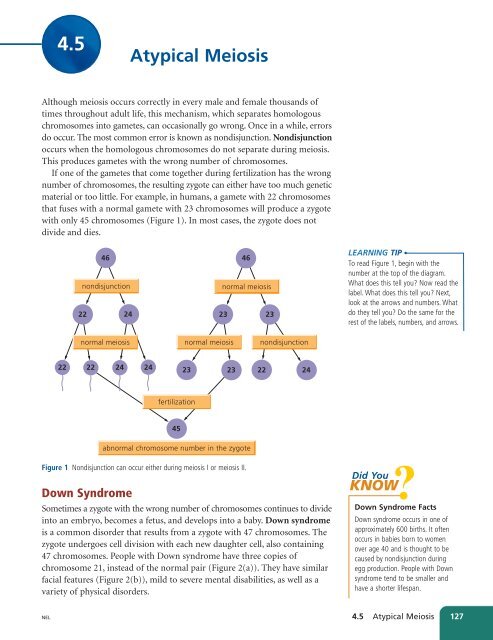Unit A Reproduction
Unit A Reproduction
Unit A Reproduction
Create successful ePaper yourself
Turn your PDF publications into a flip-book with our unique Google optimized e-Paper software.
4.5<br />
Atypical Meiosis<br />
Although meiosis occurs correctly in every male and female thousands of<br />
times throughout adult life, this mechanism, which separates homologous<br />
chromosomes into gametes, can occasionally go wrong. Once in a while, errors<br />
do occur. The most common error is known as nondisjunction. Nondisjunction<br />
occurs when the homologous chromosomes do not separate during meiosis.<br />
This produces gametes with the wrong number of chromosomes.<br />
If one of the gametes that come together during fertilization has the wrong<br />
number of chromosomes, the resulting zygote can either have too much genetic<br />
material or too little. For example, in humans, a gamete with 22 chromosomes<br />
that fuses with a normal gamete with 23 chromosomes will produce a zygote<br />
with only 45 chromosomes (Figure 1). In most cases, the zygote does not<br />
divide and dies.<br />
46<br />
nondisjunction<br />
22 24<br />
46<br />
normal meiosis<br />
23 23<br />
LEARNING TIP<br />
To read Figure 1, begin with the<br />
number at the top of the diagram.<br />
What does this tell you? Now read the<br />
label. What does this tell you? Next,<br />
look at the arrows and numbers. What<br />
do they tell you? Do the same for the<br />
rest of the labels, numbers, and arrows.<br />
normal meiosis<br />
normal meiosis<br />
nondisjunction<br />
22<br />
22 24 24 23 23 22 24<br />
fertilization<br />
45<br />
abnormal chromosome number in the zygote<br />
Figure 1 Nondisjunction can occur either during meiosis I or meiosis II.<br />
Down Syndrome<br />
Sometimes a zygote with the wrong number of chromosomes continues to divide<br />
into an embryo, becomes a fetus, and develops into a baby. Down syndrome<br />
is a common disorder that results from a zygote with 47 chromosomes. The<br />
zygote undergoes cell division with each new daughter cell, also containing<br />
47 chromosomes. People with Down syndrome have three copies of<br />
chromosome 21, instead of the normal pair (Figure 2(a)). They have similar<br />
facial features (Figure 2(b)), mild to severe mental disabilities, as well as a<br />
variety of physical disorders.<br />
Did You<br />
KNOW?<br />
Down Syndrome Facts<br />
Down syndrome occurs in one of<br />
approximately 600 births. It often<br />
occurs in babies born to women<br />
over age 40 and is thought to be<br />
caused by nondisjunction during<br />
egg production. People with Down<br />
syndrome tend to be smaller and<br />
have a shorter lifespan.<br />
NEL<br />
4.5 Atypical Meiosis 127

















